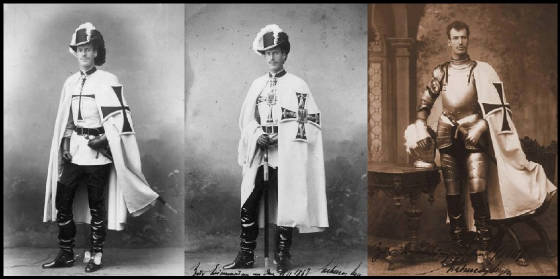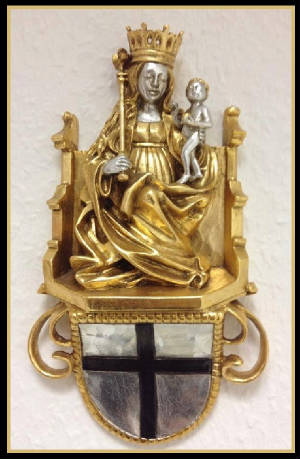Welcome
to the Website of the Teutonic Order
of the Hospital of the Virgin Mary in Jerusalem
The Teutonic Order or in
its full name the Order of the Teutonic Knights of St. Mary's Hospital in Jerusalem - looks back on a long and eventful history
of more than 800 years. Formally established as hospital brotherhood near the seaport Acre in the Holy Land in the year 1190,
during the third crusade. In the prologue of the Order's Book it reads: "Real knighthood does not only know the time-bound
form of swordplay, which has passed; the actual composure of chivalrous men is rather expressed in their commitment for the
Lord's kingdom, for protecting the defenceless, for helping the maltreated, those beset, the condemned and those in need."
It is the pronounced goal of the Knights, Brothers and Sisters of the German Order to jointly implement this composure, abiding
by the Order's motto "Helping and Healing" With this Website we would like to provide you with some insight in the
History of the Order, our work, in our roots and spirituality, in our past, but also the presence of the Order today.

Latin: Ordo domus Sanctæ Mariæ
Theutonicorum Hierosolimitanorum,
"Order of the Teutonic House of Mary in
Jerusalem"; Ordo Teutonicus,
"German Order"
German:
Deutscher Orden, "German Order";
officially Orden der Brüder vom Deutschen
Haus St. Mariens in Jerusalem,
"Order of
the Brothers of the German House of St.
Mary in Jerusalem"
Belarusian: Тэўтонскі
ордэн, "Teutonic Order"
Danish: Tyske Orden, "German Order"
Dutch: Duitse Orde, "German Order"
Croatian: Teutonski Red, "Teutonic
Order"
Estonian:
Saksa Ordu, "German Order"
Finnish: Saksalainen ritarikunta, "German Order"
French: Chevaliers Teutoniques, "Teutonic
Knights"
Hebrew:
המסדר הטבטוני ,
"The Teutonic Order"
Hungarian: Német Lovagrend, "German Knighthood"
Latvian: Vācu ordenis, "German
Order"
Lithuanian:
Kryžiuočių Ordinas, "Order of Crusaders"
Norwegian: (bokmål): Tyske Orden
Portuguese: Ordem dos Cavaleiros Teutônicos,
"Order of the Teutonic Knights"
Polish: Zakon Krzyżacki,"Order of the Crossbearers"
Romanian: Ordinul Cavalerilor Teutoni,
"Teutonic
Knights Order"
Russian:
Тевтонский орден, "Teutonic
Order"
Slovenian:
Križniki, "Crossbearers"
Slovak: Rád nemeckých rytierov
Serbian: Тевтонски
ред-Tevtonski red, "Teutonic Order"
Swedish: Tyska orden, "German Order"
Swiss German: Tütsche Ordä, "German Order"
Turkish:
Töton Şövalyeleri, "Teutonic Knights"
Italian: Ordine Teutonico, "Teutonic Order"
Spanish: Orden
Teutónica, "Teutonic Order"
Japanese: "Knights of Germany"(doitsu-kishidan)



The Introduction to the Teutonic Order of
Knights
of St Mary's Hospital in Jerusalem
The Order of the Teutonic Knights of St. Mary's Hospital in Jerusalem (Official names: Latin: Ordo domus Sanctæ
Mariæ Theutonicorum Hierosolymitanorum, German: Orden der Brüder vom Deutschen Haus St. Mariens in Jerusalem),
or for short the Teutonic Order (Today: German Teutonic Order), is a Two armed German Roman Catholic Order of Knights made
up of a Religious Arm and a Secular Arm. It was formed to aid Catholics on their pilgrimages to the Holy Land and to establish
hospitals to care for the sick and injured. Its members have commonly been known as the Teutonic Knights, since they also
served as a crusading military order during the Middle Ages. The membership was always small and whenever the need arose,
volunteers or mercenaries augmented the military forces.

Formed at the end of the 12th century in Acre, in the Levant,
the medieval Order played an important role in Outremer, controlling the port tolls of Acre. After Christian forces were defeated
in the Middle East, the Order moved to Transylvania in 1211 to help defend Hungary against the Cumans. They were expelled
in 1225 after allegedly attempting to place themselves under Papal instead of Hungarian sovereignty. In 1230, following the
Golden Bull of Rimini, Grand Master Hermann von Salza and Duke Konrad I of Masovia launched the Prussian Crusade, a joint
invasion of Prussia to Christianise the Baltic Old Prussians. The Order then created the independent Monastic State of the
Teutonic Knights in the conquered territory, and subsequently conquered Courland, Livonia, and Estonia. The Kings of Poland
accused the Order of holding lands rightfully theirs.
